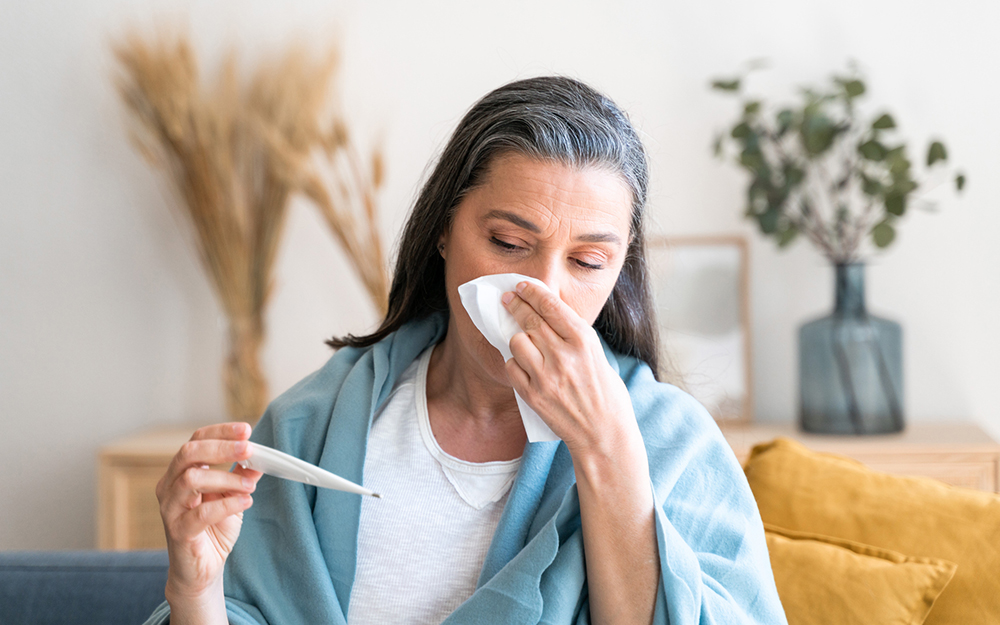What's the Difference Between a Cold, the Flu and COVID-19?
Date
October 7, 2020
Credits

Date
October 7, 2020
Credits
Medical providers featured in this article
In Brief
{{cta-block}}

As we move closer to winter, preventing viral illnesses becomes a top priority. With COVID-19 still spreading, many are wondering whether we could face a "twindemic"—a challenging flu season combined with the ongoing pandemic to overwhelm an already taxed healthcare system.
"We don't know what these viruses are going to do," says Dr. Michelle Shukhman, an internal medicine specialist at Cedars-Sinai. "They could mix together to inundate the body, or they could somehow cancel each other out."
Plus, because we're taking COVID-19 precautions—practicing physical distancing, wearing a mask and paying extra attention to hand hygiene—we might even see a decrease in colds and flu this year.
Regardless of how it plays out, if you feel a tickle in your throat or spike a fever, it's natural to wonder what you're experiencing. The good news? The treatment for each of these viruses is largely the same: rest, get plenty of fluids and treat symptoms such as fever and body aches with over-the-counter medicine.
Still wondering about the differences (and similarities) among the three? Here's how it breaks down.
Flu
While the coronavirus continues to make headlines, influenza (flu) is also a serious disease that can lead to illness or even death.
An estimated 39 to 56 million Americans came down with the flu last season, according to the Centers for Disease Control and Prevention. Almost half of them were so ill they paid a visit to their healthcare providers.
"The flu spreads mainly through respiratory droplets that travel through the air when we talk, sing, cough or sneeze," Dr. Shukhman says. It's also possible for a person to get infected with the flu by touching the same surface as someone who is infected, or by shaking hands or sharing cups and glasses.
Most people who get the flu develop symptoms within four days of infection, and those symptoms usually resolve within two weeks. Unlike COVID-19, a vaccine is available now—so the best way to protect yourself is to get a flu shot and continue to practice good hand hygiene.
Flu: When to Go to the ER
COVID-19
Coronavirus is an entire family of viruses, which like the flu, mainly spreads through respiratory droplets. Four of these viruses are similar to the common cold in terms of symptoms and severity. The novel coronavirus, or SARS-CoV-2, is a potentially deadly virus that can lead to COVID-19.
{{column-start}}
Schedule Your COVID-19 Test Online
Cedars-Sinai now offers COVID-19 testing with results available within 48–72 hours. A doctor’s referral is not necessary, and you do not need to be a Cedars-Sinai patient.
{{column-end}}
Schedule Your COVID-19 Test Online
Cedars-Sinai now offers COVID-19 testing with results available within 48–72 hours. A doctor’s referral is not necessary, and you do not need to be a Cedars-Sinai patient.
If you are a new or an existing patient to Cedars-Sinai, click here to make an appointment.
SCHEDULE AN APPOINTMENT
COVID-19 and the flu have many common symptoms, including:
- Fever
- Muscle pains and body aches
- Sore throat
- Fatigue
- Headache
- Vomiting and diarrhea
The differences between the flu and COVID-19: The latter may include a range of other signs, including loss or change in taste and smell, skin reactions and difficulty breathing. Symptoms may appear anywhere from two to 14 days after infection. The fallout from COVID-19 can last from days to months.
Common colds
A common cold can make you feel miserable, but compared to the novel coronavirus and the flu, the symptoms are usually mild and may include:
- Runny or stuffed nose
- Sneezing
- Cough
- Fatigue
- Sore throat
- Headaches
"The common cold is not as deadly, but since any built-up immunity wanes over the course of a year, you can get the same common cold multiple times," Dr. Shukhman says. Symptoms generally last seven to 10 days while your immune system battles the virus.
What to do if you're infected
If you feel sick, be it the flu, COVID-19 or the common cold, it's important to pay attention to worsening symptoms, particularly if you fall into a high-risk group (older adults, people with underlying medical conditions and pregnant women).
Suffering from only mild cold and flu-like symptoms? Take a nasal decongestant for a runny nose, a cough suppressant for a cough and acetaminophen for fever, aches and pains.
But you should still quarantine for at least 10 days before returning to your usual activities. "If you're symptomatic, you should assume you have the coronavirus, even if a test comes back negative," Dr. Shukhman says.
As with most things related to health, the best offense is a good defense.
You'll be better equipped to sidestep all viruses if you follow basic safety precautions: Wear a mask, practice good hand hygiene and maintain a safe distance between yourself and other individuals.
Then, bolster your immune system by eating a diet featuring plenty of fruits, vegetables and whole grains, exercising regularly and getting plenty of sleep. "That way, if you do get sick, you'll have a better chance for a speedy recovery," Dr. Shukhman says.





